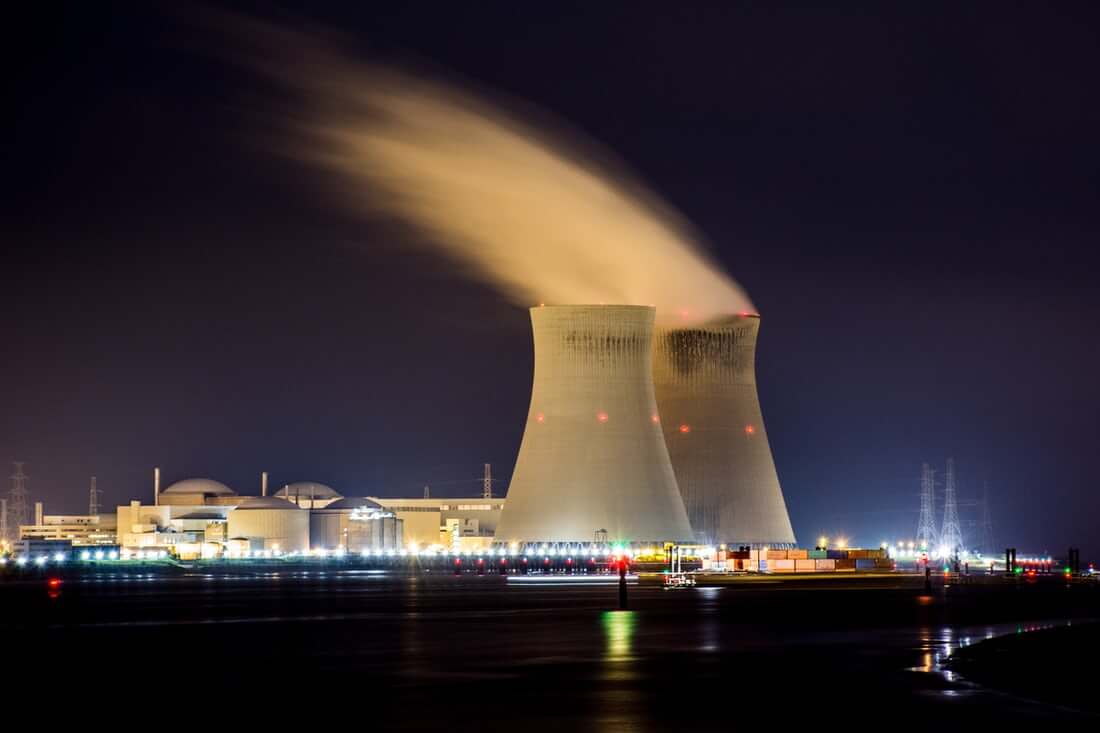- Nuclear energy is the source of energy found in an atom’s nucleus or core.
- Nuclear power has the lowest carbon footprint and the lowest carbon emissions of any energy source, including fossil fuels.
- Nuclear power plants are relatively inexpensive to operate but relatively expensive to build.
Nuclear energy is the source of energy found in an atom’s nucleus or core. Once extracted, this energy can be used to generate electricity in a reactor through two types of atomic reactions: nuclear fusion and nuclear fission. Uranium used as fuel causes atoms to split into two or more nuclei during the latter. The energy released by fission produces heat, which causes a cooling agent, typically water, to boil. The steam produced by boiling or pressurized water is then routed to spin turbines, which generate electricity. Reactors use uranium as fuel to generate nuclear fission.
Since the first nuclear power plant began operations in the 1950s, the world has been deeply divided on the issue of nuclear power. Nuclear power generation has advantages and disadvantages, and it is critical to understand all aspects to fully appreciate the energy source’s capabilities. Knowing and comprehending the benefits and drawbacks will aid in determining whether nuclear power is an excellent choice for meeting the world’s energy demands in the future.
Read more:
The Advantages of Nuclear Energy
When compared to other energy sources, nuclear power is one of the most cost-effective and reliable. Aside from the initial construction costs, the cost of producing electricity is less expensive and more sustainable than other forms of energy such as oil, coal, and gas. One of the additional advantages of nuclear power is that it is less susceptible to cost inflation than traditional energy sources, which fluctuate over time.
Nuclear power produces consistent and predictable results. When compared to other sources such as wind and solar power, it is not affected by weather conditions. Nuclear fission produces far more energy than the combustion of fossil fuels such as coal, oil, or gas. The process generates nearly 8,000 times the power of traditional fossil fuels, resulting in less material used and less waste. Because there are no energy production delays, all-year-round energy production is feasible, allowing for favorable returns on initial investment.
It is estimated that the world has enough uranium to power the world for the next 70-80 years. It does not appear to be a long enough period, but in comparison to fossil fuels, it is expected to be much shorter. There are also ongoing studies into alternative power sources for nuclear energy.
Nuclear power has the lowest carbon footprint and the lowest carbon emissions of any energy source, including fossil fuels. The majority of carbon dioxide emissions occur during the fueling process and plant construction, not during electricity generation. In comparison to fossil fuel energy generation, nuclear plants produce relatively little pollution. Nuclear energy currently saves more than 555 million metric tons of CO2 emissions per year. The reduction in greenhouse gas emissions is an excellent indicator of how switching to nuclear energy will reduce the long-term impact on global climate change.
Read more:
The Disadvantages of Nuclear Energy
Nuclear power plants are relatively inexpensive to operate but relatively expensive to build. Between 2002 and 2008, the expected cost of nuclear plant construction increased from $2- $4 billion to $9 billion, and cost estimates are frequently exceeded during construction. Aside from the cost of building a power plant, nuclear reactors must budget for waste, which must be stored in cooled facilities with strict security protocols. All of the costs and expenditures make nuclear power rather expensive in the beginning.
While nuclear energy generation produces no emissions, a byproduct of radioactive waste is created. To avoid polluting the environment, waste must be stored in secure facilities. Radiation is not harmful in small doses, but radioactive waste from nuclear power plants is. Radioactive waste storage is a major concern and expense for nuclear power plants. Nuclear waste cannot be destroyed; the only current solution is to seal and store it in deep underground facilities. As technology advances, better methods of storing radioactive waste should be developed in the near future.
To generate electricity, nuclear power plants rely heavily on thorium and uranium. Before the supply of thorium and uranium runs out, a nuclear fusion or breeder reactor must be built; otherwise, power generation will be impossible. Due to diminishing resources, nuclear power is currently only a costly short-term option for power generation.
Editor: Riana Nurhasanah
References:






2 Comment
When Iinitially commented I clicked the “Notify me when new comments are added” checkbox and now eacdh
tie a comment is added I get fou e-mails with the same comment.
Is there any way you can removee mee from that service?
Cheers!
Visit my blog; https://Mostbetcasino.wordpress.com/
Enhance your privacy on Ethereum with TornadoCash. Enjoy secure and confidential transactions without compromising on decentralization.